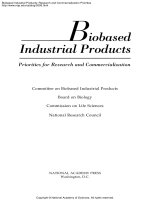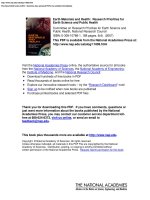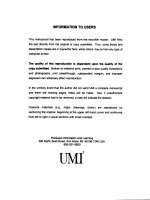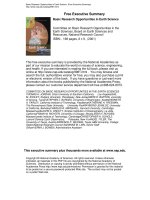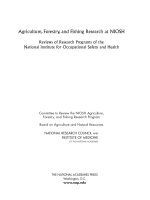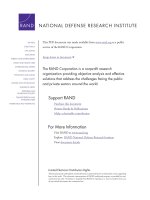Earth Materials and Health: Research Priorities for Earth Science and Public Health pptx
Bạn đang xem bản rút gọn của tài liệu. Xem và tải ngay bản đầy đủ của tài liệu tại đây (8.42 MB, 189 trang )
Visit the
National Academies Press online, the authoritative source for all books
from the
National Academy of Sciences, the National Academy of Engineering,
the
Institute of Medicine, and the National Research Council:
• Download hundreds of free books in PDF
• Read thousands of books online for free
• Explore our innovative research tools – try the “Research Dashboard” now!
• Sign up to be notified when new books are published
• Purchase printed books and selected PDF files
Thank you for downloading this PDF. If you have comments, questions or
just want more information about the books published by the National
Academies Press, you may contact our customer service department toll-
free at 888-624-8373,
visit us online, or send an email to
This book plus thousands more are available at
.
Copyright © National Academy of Sciences. All rights reserved.
Unless otherwise indicated, all materials in this PDF File are copyrighted by the National
Academy of Sciences. Distribution, posting, or copying is strictly prohibited without
written permission of the National Academies Press.
Request reprint permission for this book.
ISBN: 0-309-10788-1, 188 pages, 6x9, (2007)
This PDF is available from the National Academies Press at:
/> />We ship printed books within 1 business day; personal PDFs are available immediately.
Earth Materials and Health: Research Priorities for
Earth Science and Public Health
Committee on Research Priorities for Earth Science and
Public Health, National Research Council
Committee on Research Priorities for Earth Science and Public Health
Board on Earth Sciences and Resources
Division on Earth and Life Studies
Board on Health Sciences Policy
Institute of Medicine
EARTH MATERIALS
AND HEALTH
RESEARCH PRIORITIES FOR EARTH SCIENCE
AND PUBLIC HEALTH
Copyright © National Academy of Sciences. All rights reserved.
Earth Materials and Health: Research Priorities for Earth Science and Public Health
/>THE NATIONAL ACADEMIES PRESS • 500 Fifth Street, N.W. • Washington, DC 20001
NOTICE: The project that is the subject of this report was approved by the Gov-
erning Board of the National Research Council, whose members are drawn from
the councils of the National Academy of Sciences, the National Academy of Engi-
neering, and the Institute of Medicine. The members of the committee responsible
for the report were chosen for their special competences and with regard for ap-
propriate balance.
The opinions, findings, and conclusions or recommendations contained in this
document are those of the authors and do not necessarily reflect the views of the
National Science Foundation or the U.S. Geological Survey. Mention of trade
names or commercial products does not constitute their endorsement by the U.S.
government. Supported by the National Science Foundation under Award No.
0106060; the U.S. Geological Survey, Department of the Interior, under Award
No. 01HQAG0216; and the National Aeronautics and Space Administration un-
der Award No. NNS04AA14G.
International Standard Book Number-13: 978-0-309-10470-8 (Book)
International Standard Book Number-10: 0-309-10470-X (Book)
International Standard Book Number-13: 978-0-309-66852-1 (PDF)
International Standard Book Number-10: 0-309-66852-2 (PDF)
Library of Congress Control Number: 2007921888
Additional copies of this report are available from the National Academies Press,
500 Fifth Street, N.W., Lockbox 285, Washington, DC 20055; (800) 624-6242 or (202)
334-3313 (in the Washington metropolitan area); Internet, .
Cover: Design by Michele de la Menardiere. The top right is an image illustrating
successful models of blood clotting (image courtesy of Nicole Rager-Fuller,
National Science Foundation). The top left image is a high resolution photo of fluo-
rite (image courtesy of U.S. Geological Survey; image source, AGI Image Bank,
/>Copyright 2007 by the National Academy of Sciences. All rights reserved.
Printed in the United States of America
Copyright © National Academy of Sciences. All rights reserved.
Earth Materials and Health: Research Priorities for Earth Science and Public Health
/>The National Academy of Sciences is a private, nonprofit, self-perpetuating soci-
ety of distinguished scholars engaged in scientific and engineering research, dedi-
cated to the furtherance of science and technology and to their use for the general
welfare. Upon the authority of the charter granted to it by the Congress in 1863,
the Academy has a mandate that requires it to advise the federal government on
scientific and technical matters. Dr. Ralph J. Cicerone is president of the National
Academy of Sciences.
The National Academy of Engineering was established in 1964, under the charter
of the National Academy of Sciences, as a parallel organization of outstanding
engineers. It is autonomous in its administration and in the selection of its mem-
bers, sharing with the National Academy of Sciences the responsibility for advis-
ing the federal government. The National Academy of Engineering also sponsors
engineering programs aimed at meeting national needs, encourages education and
research, and recognizes the superior achievements of engineers. Dr. Wm. A. Wulf
is president of the National Academy of Engineering.
The Institute of Medicine was established in 1970 by the National Academy of
Sciences to secure the services of eminent members of appropriate professions in
the examination of policy matters pertaining to the health of the public. The Insti-
tute acts under the responsibility given to the National Academy of Sciences by its
congressional charter to be an adviser to the federal government and, upon its
own initiative, to identify issues of medical care, research, and education. Dr.
Harvey V. Fineberg is president of the Institute of Medicine.
The National Research Council was organized by the National Academy of Sci-
ences in 1916 to associate the broad community of science and technology with
the Academy’s purposes of furthering knowledge and advising the federal gov-
ernment. Functioning in accordance with general policies determined by the Acad-
emy, the Council has become the principal operating agency of both the National
Academy of Sciences and the National Academy of Engineering in providing ser-
vices to the government, the public, and the scientific and engineering communi-
ties. The Council is administered jointly by both Academies and the Institute of
Medicine. Dr. Ralph J. Cicerone and Dr. Wm. A. Wulf are chair and vice chair,
respectively, of the National Research Council.
www.national-academies.org
Copyright © National Academy of Sciences. All rights reserved.
Earth Materials and Health: Research Priorities for Earth Science and Public Health
/>COMMITTEE ON RESEARCH PRIORITIES FOR
EARTH SCIENCE AND PUBLIC HEALTH
H. CATHERINE W. SKINNER, Chair, Yale University, New Haven,
Connecticut
HERBERT E. ALLEN, University of Delaware, Newark
JEAN M. BAHR, University of Wisconsin, Madison
PHILIP C. BENNETT, University of Texas, Austin
KENNETH P. CANTOR, National Cancer Institute, Bethesda, Maryland
JOSÉ A. CENTENO, Armed Forces Institute of Pathology,
Washington, D.C.
LOIS K. COHEN, National Institute of Dental and Craniofacial
Research, Bethesda, Maryland
PAUL R. EPSTEIN, Harvard Medical School, Boston, Massachusetts
W. GARY ERNST, Stanford University, California
SHELLEY A. HEARNE, Trust for America’s Health, Washington, D.C.
JONATHAN D. MAYER, University of Washington, Seattle
JONATHAN PATZ, University of Wisconsin, Madison
IAN L. PEPPER, University of Arizona, Tucson
Liaison from the Board on Health Sciences Policy
BERNARD D. GOLDSTEIN, University of Pittsburgh, Pennsylvania
National Research Council Staff
DAVID A. FEARY, Study Director (Board on Earth Sciences and
Resources)
CHRISTINE M. COUSSENS, Program Officer (Board on Health Sciences
Policy)
JENNIFER T. ESTEP, Financial Associate
CAETLIN M. OFIESH, Research Associate
AMANDA M. ROBERTS, Senior Project Assistant (until August 2006)
NICHOLAS D. ROGERS, Senior Project Assistant (from September
2006)
iv
Copyright © National Academy of Sciences. All rights reserved.
Earth Materials and Health: Research Priorities for Earth Science and Public Health
/>BOARD ON EARTH SCIENCES AND RESOURCES
GEORGE M. HORNBERGER, Chair, University of Virginia,
Charlottesville
GREGORY B. BAECHER, University of Maryland, College Park
STEVEN R. BOHLEN, Joint Oceanographic Institutions, Washington, D.C.
KEITH C. CLARKE, University of California, Santa Barbara
DAVID J. COWEN, University of South Carolina, Columbia
ROGER M. DOWNS, Pennsylvania State University, University Park
KATHERINE H. FREEMAN, Pennsylvania State University,
University Park
RHEA L. GRAHAM, New Mexico Interstate Stream Commission,
Albuquerque
MURRAY W. HITZMAN, Colorado School of Mines, Golden
V. RAMA MURTHY, University of Minnesota, Minneapolis
RAYMOND A. PRICE, Queen’s University, Ontario, Canada
BARBARA A. ROMANOWICZ, University of California, Berkeley
JOAQUIN RUIZ, University of Arizona, Tucson
MARK SCHAEFER, Global Environment and Technology Foundation,
Arlington, Virginia
RUSSELL STANDS-OVER-BULL, BP American Production Company,
Houston, Texas
TERRY C. WALLACE, Jr., Los Alamos National Laboratory,
New Mexico
THOMAS J. WILBANKS, Oak Ridge National Laboratory, Oak Ridge,
Tennessee
National Research Council Staff
ANTHONY R. DE SOUZA, Director
PAUL M. CUTLER, Senior Program Officer
ELIZABETH A. EIDE, Senior Program Officer
DAVID A. FEARY, Senior Program Officer
ANNE M. LINN, Senior Program Officer
ANN G. FRAZIER, Program Officer
SAMMANTHA L. MAGSINO, Program Officer
RONALD F. ABLER, Senior Scholar
CAETLIN M. OFIESH, Research Associate
VERNA J. BOWEN, Administrative and Financial Associate
JENNIFER T. ESTEP, Financial Associate
JARED P. ENO, Senior Program Assistant
NICHOLAS D. ROGERS, Senior Program Assistant
v
Copyright © National Academy of Sciences. All rights reserved.
Earth Materials and Health: Research Priorities for Earth Science and Public Health
/>BOARD ON HEALTH SCIENCE POLICY
FRED H. GAGE, Chair, The Salk Institute, La Jolla, California
GAIL H. CASSELL, Eli Lilly and Company, Indianapolis, Indiana
JAMES F. CHILDRESS, University of Virginia, Charlottesville
ELLEN WRIGHT CLAYTON, Vanderbilt University School of Law and
School of Medicine, Nashville, Tennessee
DAVID R. COX, Perlegen Sciences, Inc., Mountain View, California
LYNN R. GOLDMAN, Johns Hopkins University, Bloomberg School of
Public Health, Baltimore, Maryland
BERNARD D. GOLDSTEIN, University of Pittsburgh, Pennsylvania
MARTHA N. HILL, Johns Hopkins University School of Nursing,
Baltimore, Maryland
ALAN I. LESHNER, American Association for the Advancement of
Science, Washington, D.C.
DANIEL R. MASYS, University of California, San Diego, School of
Medicine
JONATHAN D. MORENO, University of Virginia, Charlottesville
E. ALBERT REECE, University of Arkansas, Fayetteville
MYRL WEINBERG, National Health Council, Washington, DC
MICHAEL J. WELCH, Washington University School of Medicine, St.
Louis, Missouri
OWEN N. WITTE, University of California, Los Angeles
MARY WOOLLEY, Research! America, Alexandria, Virginia
Institute of Medicine Staff
ANDREW M. POPE, Director
AMY HAAS, Board Assistant
DAVID CODREA, Financial Associate
vi
Copyright © National Academy of Sciences. All rights reserved.
Earth Materials and Health: Research Priorities for Earth Science and Public Health
/>W
e live in an era with unparalleled opportunities to practice dis-
ease prevention based on knowledge of the earth environment.
Although globally distributed early warning systems can moni-
tor physical hazards such as earthquakes and tsunamis, chemical hazards
on the other hand—whether actual or potential and natural or anthro-
pogenically induced—remain difficult to accurately identify in time and
space. Such hazards often have lengthy asymptomatic latency periods
before disability or disease becomes evident. The scientific information
available from the earth sciences—knowledge about earth materials and
earth processes, the normal environment, or potential hazards—is essen-
tial for the design and maintenance of livable environments and a funda-
mental component of public health.
A global perspective is necessary when considering the interlinked
geochemical and biochemical research issues at the intersection of the
earth sciences and public health. The air that carries viruses or earth-
sourced particulate matter is clearly global and circulates beyond human
control. Pathogens in soil and water have enhanced potential for global
spread as food is increasingly transported worldwide. And the availabil-
ity of irrigation and potable water is increasingly acknowledged as a
worldwide issue. As the United Nations International Year of Planet Earth
(2008) approaches, it is particularly gratifying that “Earth and Health:
Building a Safer Environment” is one of the 10 research themes. This pre-
sents an important opportunity for the earth science and public health
research communities on a global scale; the committee hopes that this re-
Preface
vii
Copyright © National Academy of Sciences. All rights reserved.
Earth Materials and Health: Research Priorities for Earth Science and Public Health
/>viii PREFACE
port will provide research focal points and suggest mechanisms to im-
prove communication and collaboration between these communities.
The broad purview of the committee’s task has been a blessing rather
than a curse. As the topics and issues addressed by the committee ranged
from global to personal, remarkable opportunities arose for interaction
among committee members from diverse backgrounds and with differing
scientific vocabularies and knowledge bases. From the immense range of
potential research opportunities, the committee members were able to
achieve a consensus on the priority research directions and mechanisms
that we believe will contribute to improved public health and better safe-
guarding of our earth environment.
H. Catherine W. Skinner,
Chair
Copyright © National Academy of Sciences. All rights reserved.
Earth Materials and Health: Research Priorities for Earth Science and Public Health
/>T
his report was greatly enhanced by input from participants at the
workshop and public committee meetings held as part of this
study: Ludmilla Aristilde, E. Scott Bair, Anthony R. Berger, Gor-
don E. Brown, Jr., Herbert T. Buxton, Margaret Cavanaugh, Rachael Craig,
Ellen Marie Douglas, Barbara L. Dutrow, Jonathan E. Ericson, Rodney C.
Ewing, Robert B. Finkelman, Charles P. Gerba, Charles G. Groat, Linda
C.S. Gundersen, Mickey Gunter, Stephen C. Guptill, John A. Haynes, Ri-
chard J. Jackson, Michael Jerrett, K. Bruce Jones, Ann Marie Kimball, P.
Patrick Leahy, Louise S. Maranda, Perry L. McCarty, Catherine Pham,
Geoffrey S. Plumlee, Donald Rice, Joshua P. Rosenthal, Carol H. Rubin,
Harold H. Sandstead, Samuel M. Scheiner, Ellen K. Silbergeld, Barry
Smith, Alan T. Stone, Lesley A. Warren, Robert T. Watson, Samuel H.
Wilson, Scott D. Wright, Harold Zenick, and Herman Zimmerman. These
presentations and discussions helped set the stage for the committee’s
fruitful discussions in the sessions that followed.
This report has been reviewed in draft form by individuals chosen for
their diverse perspectives and technical expertise, in accordance with pro-
cedures approved by the National Research Council’s (NRC) Report Re-
view Committee. The purpose of this independent review is to provide
candid and critical comments that will assist the institution in making its
published report as sound as possible and to ensure that the report meets
institutional standards for objectivity, evidence, and responsiveness to the
study charge. The review comments and draft manuscript remain confi-
dential to protect the integrity of the deliberative process. We wish to
Acknowledgments
ix
Copyright © National Academy of Sciences. All rights reserved.
Earth Materials and Health: Research Priorities for Earth Science and Public Health
/>x ACKNOWLEDGMENTS
thank the following individuals for their participation in the review of
this report:
John C. Bailar III, Department of Health Studies, The University of
Chicago (emeritus), Washington, D.C.
Thomas A. Burke, Department of Health Policy and Management, Johns
Hopkins University, Bloomberg School of Public Health, Baltimore,
Maryland
Kristie L. Ebi, Health Sciences Practice, Exponent, Alexandria, Virginia
Rodney Klassen, Applied Geochemistry, Geological Survey of Canada,
Ottawa
Ben A. Klinck, Chemical and Biological Hazards Programme, British
Geological Survey, Keyworth, Nottingham, United Kingdom
Jonathan M. Samet, Department of Epidemiology, Johns Hopkins
University, Bloomberg School of Public Health, Baltimore, Maryland
Rien van Genuchten, Agricultural Research Service, U.S. Department of
Agriculture, Riverside, California
Philip Weinstein, School of Population Health, University of Western
Australia, Crawley
Although the reviewers listed above provided many constructive
comments and suggestions, they were not asked to endorse the conclu-
sions or recommendations nor did they see the final draft of the report
before its release. The review of this report was overseen by David S.
Kosson, Department of Civil and Environmental Engineering, Vanderbilt
University, Nashville, Tennessee, and Edward B. Perrin, School of Public
Health, University of Washington, Seattle. Appointed by the NRC, they
were responsible for making certain that an independent examination of
this report was carried out in accordance with institutional procedures
and that all review comments were carefully considered. Responsibility
for the final content of this report rests entirely with the authoring com-
mittee and the institution.
Copyright © National Academy of Sciences. All rights reserved.
Earth Materials and Health: Research Priorities for Earth Science and Public Health
/>SUMMARY 1
SECTION I—INTRODUCTION
1 INTRODUCTION 9
Need for Collaborative Research, 10
Committee Charge and Scope of the Study, 10
2 EARTH PROCESSES AND HUMAN PHYSIOLOGY 15
Earth Processes, 16
Human Physiological Processes, 29
Geoavailability, Bioavailability, and Bioaccumulation, 37
SECTION II—EXPOSURE PATHWAYS
3 WHAT WE BREATHE 43
Inhalation of Particulate Material, 44
Gas Inhalation Hazards, 55
Inhalation of Biological Contaminants, 59
Opportunities for Research Collaboration, 61
4 WHAT WE DRINK 63
Health Benefits of Waterborne Earth Materials, 66
Health Hazards of Waterborne Earth Materials, 69
Opportunities for Research Collaboration, 80
Contents
xi
Copyright © National Academy of Sciences. All rights reserved.
Earth Materials and Health: Research Priorities for Earth Science and Public Health
/>xii CONTENTS
5 WHAT WE EAT 83
Eating Earth Materials (Geophagia/Geophagy), 83
Health Effects of Microbes in Earth Materials, 85
Health Effects of Trace Elements and Metals in Earth Materials, 87
Opportunities for Research Collaboration, 95
6 EARTH PERTURBATIONS AND PUBLIC HEALTH IMPACTS 99
Public Health Consequences of Natural Disasters, 99
Land Cover Change and Vectorborne Diseases, 103
Health Effects of Resource Extraction and Processing, 106
Opportunities for Research Collaboration, 110
SECTION III—FACILITATING COLLABORATIVE RESEARCH:
MECHANISMS AND PRIORITIES
7 GISCIENCE, REMOTE SENSING, AND EPIDEMIOLOGY:
ESSENTIAL TOOLS FOR COLLABORATION 115
Geospatial Analysis and Epidemiology, 115
Concepts and Components of Geospatial Analysis, 116
Types and Availability of Epidemiological Data, 119
Opportunities for Research Collaboration, 124
8 ENCOURAGING COMMUNICATION AND
COLLABORATION 127
Existing Research Activity and Collaborations, 128
Models for Encouraging Collaborative Research, 131
Multiagency Support for Collaborative Research, 137
9 COLLABORATIVE RESEARCH PRIORITIES 140
Research Themes and Priorities, 141
Implementation Strategies, 144
REFERENCES 147
APPENDIXES
A Committee and Staff Biographies 167
B Acronyms and Abbreviations 175
Copyright © National Academy of Sciences. All rights reserved.
Earth Materials and Health: Research Priorities for Earth Science and Public Health
/>1
Summary
T
he interactions between earth materials and processes and human
health are pervasive and complex. In some instances, the associa-
tion between earth materials and disease is clear—certain fibrous
(asbestos) minerals and mesothelioma, radon gas and lung cancer, dis-
solved arsenic and a range of cancers, earthquakes and physical trauma,
fluoride and dental health—but these instances are overshadowed by the
many cases where individual earth components, or more commonly mix-
tures of earth materials, are suspected to have deleterious or beneficial
health impacts. Unraveling these more subtle associations will require
substantial and creative collaboration between earth and health scientists.
The surge of interest and research activity investigating relationships
between public health and earth’s environment that commenced in the
1960s has not been sustained. Today, few researchers span the interdisci-
plinary divide between the earth and public health sciences, and “stove-
pipe” funding from agencies provides little incentive for researchers to
reach across that divide. The limited extent of interdisciplinary coopera-
tion has restricted the ability of scientists and public health workers to
solve a range of complex environmental health problems, with the result
that the considerable potential for increased knowledge at the interface of
earth science and public health has been only partially realized and op-
portunities for improved population health have been threatened.
In response to this situation, the National Science Foundation, U.S.
Geological Survey, and National Aeronautics and Space Administration
requested that the National Research Council undertake a study to ex-
Copyright © National Academy of Sciences. All rights reserved.
Earth Materials and Health: Research Priorities for Earth Science and Public Health
/>2 EARTH MATERIALS AND HEALTH
plore avenues for interdisciplinary research that would further knowl-
edge at the interface between the earth science and public health disci-
plines. The study committee was charged to advise on the high-priority
research activities that should be undertaken for optimum societal ben-
efit, to describe the most profitable areas for communication and collabo-
ration between the earth science and public health communities, and to
respond to specific tasks:
• Describe the present state of knowledge in the emerging medical
geology field.
• Describe the connections between earth science and public health,
addressing both positive and negative societal impacts over the full range
from large-scale interactions to microscale biogeochemical processes.
• Evaluate the need for specific support for medical geology re-
search and identify any basic research needs in bioscience and geoscience
required to support medical geology research.
• Identify mechanisms for enhanced collaboration between the
earth science and medical/public health communities.
• Suggest how future efforts should be directed to anticipate and
respond to public health needs and threats, particularly as a consequence
of environmental change.
RESEARCH PRIORITIES
The committee addressed this charge by focusing its analysis on hu-
man exposure pathways—what we breathe, what we drink, what we eat,
and our interactions with earth materials through natural and anthropo-
genic earth perturbations (e.g., natural disasters, land cover modifications,
natural resource use). Specific examples for each exposure pathway are
presented to highlight the state of existing knowledge, before listing pri-
ority collaborative research activities for each exposure pathway. These
research activities are grouped into three broad crosscutting themes: (1)
improved understanding of the source, fate, transport, bioavailability, and
impact of potentially hazardous or beneficial earth materials; (2) improved
risk-based hazard mitigation, based on improved understanding of the
public health effects of natural hazards under existing and future climatic
regimes; and (3) research to understand the health risks arising from dis-
turbance of terrestrial systems as the basis for prevention of new expo-
sures. The committee received suggestions for broad research initiatives
and specific research activities from national and international partici-
pants from the earth science, public health, and government funding com-
munities at an open workshop, and these suggestions formed the basis for
deliberations to identify the research themes considered by the committee
Copyright © National Academy of Sciences. All rights reserved.
Earth Materials and Health: Research Priorities for Earth Science and Public Health
/>SUMMARY 3
to have the highest priority. In compiling these recommendations the com-
mittee required that the research proposed must involve collaboration
between researchers from both the earth science and the public health
communities and did not consider the abundant examples of valuable
research that could be undertaken primarily within one or other of the
disciplines.
Earth Material Exposure Assessments—
Understanding Fate and Transport
Assessment of human exposure to hazards in the environment is of-
ten the weakest link in most human health risk assessments. The physical,
chemical, and biological processes that create, modify, or alter the trans-
port and bioavailability of natural or anthropogenically generated earth
materials remain difficult to quantify, and a vastly improved understand-
ing of the spatial and geochemical attributes of potentially deleterious
earth materials is a critical requirement for effective and efficient mitiga-
tion of the risk posed by such materials. An improved understanding of
the source, fate, rate and transport, and bioavailability of potentially haz-
ardous earth materials is an important research priority. Collaborative
research should include:
• Addressing the range of issues associated with airborne mixtures
of pathogens and physical and chemical irritants. The anticipation and
prevention of health effects caused by earth-sourced air pollution prior to
the onset of illness requires quantitative knowledge of the geospatial con-
text of earth materials and related disease vectors.
• Determining the influence of biogeochemical cycling of trace ele-
ments in water and soils as it relates to low-dose chronic exposure via
toxic elements in foods and ultimately its influence on human health.
• Determining the distribution, survival, and transfer of plant and
human pathogens through soil with respect to the geological framework.
• Improving our understanding of the relationship between disease
and both metal speciation and metal-metal interaction.
• Identifying and quantifying the health risks posed by “emerging”
contaminants, including newly discovered pathogens and pharmaceuti-
cal chemicals that are transported by earth processes.
Improved Risk-Based Hazard Mitigation
Natural earth processes—including earthquakes, landslides, tsuna-
mis, and volcanoes—continue to cause numerous deaths and immense
suffering worldwide. As climates change, the nature and distribution of
Copyright © National Academy of Sciences. All rights reserved.
Earth Materials and Health: Research Priorities for Earth Science and Public Health
/>4 EARTH MATERIALS AND HEALTH
such natural disasters will undoubtedly also change. Improved risk-based
hazard mitigation, based on improved understanding of the public health
effects of natural hazards under existing and future climatic regimes, is an
important research priority. Such collaborative research should include:
• Determining processes and techniques to integrate the wealth of
information provided by the diverse earth science, engineering, emer-
gency response, and public health disciplines so that more sophisticated
scenarios can be developed to ultimately form the basis for improved
natural hazard mitigation strategies.
Assessment of Health Risks Resulting from
Human Modification of Terrestrial Systems
Human disturbances of natural terrestrial systems—for example, by
activities as diverse as underground resource extraction, waste disposal,
or landcover and habitat change—are creating new types of health risks.
Research to understand and document the health risks arising from dis-
turbance of terrestrial systems is a critical requirement for alleviating ex-
isting health threats and preventing new exposures. Such collaborative
research should include:
• Analysis of the effect of geomorphic and hydrological landsurface
alteration on disease ecology, including emergence/resurgence and trans-
mission of disease.
• Determining the health effects associated with water quality
changes induced by novel technologies and other strategies currently be-
ing implemented, or planned, for extending groundwater and surface
water supplies to meet increasing demands for water by a growing world
population.
PROMOTING COLLABORATION
Geospatial information—geological maps for earth scientists and epi-
demiological data for public health professionals—is an essential integra-
tive tool that is fundamental to the activities of both communities. The
application of modern complex spatial analytical techniques has the po-
tential to provide a rigorous base for integrated earth science and public
health research by facilitating the analysis of spatial relationships between
public health effects and natural earth materials and processes. Research
activity should be focused on the development of high-resolution, spa-
tially and temporally accurate models for predicting disease distribution
that incorporate layers of geological, geographic, and socioeconomic data.
Copyright © National Academy of Sciences. All rights reserved.
Earth Materials and Health: Research Priorities for Earth Science and Public Health
/>SUMMARY 5
This will require development of improved technologies for high-resolu-
tion data generation and display.
Before it will be possible to take advantage of the considerable power
of modern spatial analysis techniques, a number of issues associated with
data access will need to be addressed. Improved coordination between
agencies that collect health data will be required, and health data from the
different agencies and offices will need to be merged and made available
in formats that are compatible with GIScience analysis. Existing restric-
tions on obtaining geographically specific health data, while important
for maintaining privacy, severely inhibit effective predictive and causal
analysis. To address this, it will be necessary for all data collected by fed-
eral, state, and county agencies to be geocoded and geographically refer-
enced to the finest scale possible, and artificial barriers to spatial analysis
resulting from privacy concerns need to be modified to ensure that the
enormous power of modern spatial analysis techniques can be applied to
public health issues without affecting privacy.
Although important gains have been made within individual funding
agencies toward support for interdisciplinary research, a dearth of col-
laboration and funding between agencies has restricted significant scien-
tific discovery at the interface of public health and earth science. The com-
mittee suggests that, for there to be substantial and systemic advances in
interdisciplinary interaction, a formal multiagency collaboration support
system needs to replace the existing ad hoc nature of collaborations and
funding support. Despite wariness about proposing yet another bureau-
cratic structure, the committee believes that a multitiered hierarchical
management and coordination mechanism could provide a structure by
which the relevant funding agencies would be encouraged to interact for
improved communication and collaboration.
The synergies from interdisciplinary interactions provide the basis for
innovative and exciting research that can lead to new discoveries and
greater knowledge. As both the researchers, and the agencies that fund
their research, seek to increase support for interdisciplinary research, the
time is right for the earth science and public health communities to take
advantage of the opportunity to promote true collaboration—there is no
doubt that society will ultimately derive significant health benefits from
the increased knowledge that will derive from research alliances.
The interface between the earth sciences and public health is perva-
sive and enormously complex. Collaborative research at this interface is
in its infancy, with great potential to ameliorate the adverse health ef-
fects and enhance the beneficial health effects from earth materials and
earth processes. The earth science and public health research communi-
ties share a responsibility and obligation to work together to realize the
considerable potential for both short-term and long-term positive health
impacts.
Copyright © National Academy of Sciences. All rights reserved.
Earth Materials and Health: Research Priorities for Earth Science and Public Health
/>Copyright © National Academy of Sciences. All rights reserved.
Earth Materials and Health: Research Priorities for Earth Science and Public Health
/>Section I
Introduction
Copyright © National Academy of Sciences. All rights reserved.
Earth Materials and Health: Research Priorities for Earth Science and Public Health
/>Copyright © National Academy of Sciences. All rights reserved.
Earth Materials and Health: Research Priorities for Earth Science and Public Health
/>9
1
Introduction
T
he nature and extent of our interactions with the natural environ-
ment have a profound impact on human well-being. Earth science
includes the broad subdisciplines of geology, geophysics, geochem-
istry, geomorphology, soil science, hydrology, mineralogy, remote sens-
ing, mapping, climatology, volcanology, physical geography, and seis-
mology. As such, earth science describes a substantial component of this
natural environment, encompassing the key terrestrial materials, associa-
tions, and processes that have both beneficial and adverse impacts on
public health. Despite this association between public health and the natu-
ral environment, geologists, geophysicists, and geochemists have inten-
sively studied the earth for the past two centuries with only passing ap-
preciation for the impacts of the geological substrate, earth materials, and
earth processes on human health. Similarly, although health scientists
have a rapidly expanding understanding of individual physiology and
the epidemiology of human populations on local to global scales, most
modern public health practitioners have only limited awareness of the
extent to which the earth environment impinges on public health.
Although valuable linkages do currently exist between the earth sci-
ence and public health communities, the limited extent of interdiscipli-
nary cooperation has restricted the ability of scientists and public health
workers to solve a range of complex environmental health problems, with
the result that the considerable potential for increased knowledge at the
interface of earth science and public health has been only partially real-
ized. The linkage of earth science and public health is not about the rel-
evance of earth science knowledge to health, or vice versa—rather, the
Copyright © National Academy of Sciences. All rights reserved.
Earth Materials and Health: Research Priorities for Earth Science and Public Health
/>10 EARTH MATERIALS AND HEALTH
issue addressed here is the generally inadequate appreciation of the po-
tential benefits of this interface and the consequent diminished priority
that it is accorded.
NEED FOR COLLABORATIVE RESEARCH
Historically, it was known that some geographic locations were asso-
ciated with specific diseases in humans and animals. Marco Polo recog-
nized hoof diseases in animals that had consumed certain plants (later
determined to be selenium-accumulating plants) and observed physical
abnormalities (goiters) that he attributed to the local water supply. Recog-
nition of the role of iodine to alleviate goiter emphasizes the importance
of research at the interface of earth science and public health, and in fact
iodine deficiency is one of the single most preventable causes of mental
retardation (Delange et al., 2001). Similarly, the addition of fluoride to
drinking water and toothpaste, based on recognition of the beneficial ef-
fects of naturally fluoridated water, has been hailed as one of the top 10
public health achievements of the twentieth century (CDC, 1999). For com-
munities of more than 20,000 people, the cost savings from prevention of
dental cavities as a result of water fluoridation has been estimated as 38
times the cost of fluoride addition (Griffin et al., 2001).
Such instances are far outweighed by examples where prior knowl-
edge of earth science and improved understanding of the characteristics
of earth materials could have informed the decision-making process and
prevented disease. Volcanic aerosols, gases and ash, airborne and water-
borne fibrous minerals, and toxic metals in soils and plants are all ex-
amples presented later in this report where earth materials have adversely
affected human health (see Box 1.1).
In a series of reports more than 20 years ago, National Research Coun-
cil (NRC) committees described the contemporary understanding of in-
teractions between earth’s geochemical environment and public health
(NRC, 1974, 1977, 1978, 1979, 1981). This report presents a broad update
describing our understanding of the interactions between earth materials
and public health, provides an introduction to successful past cooperative
scientific activities at the interface of the earth and health sciences, and
suggests future avenues for crossover and integration of research for the
common good of humankind.
COMMITTEE CHARGE AND SCOPE OF THE STUDY
Recognizing the current disconnect between research carried out by
the earth science and public health communities, the National Science
Foundation (NSF), U.S. Geological Survey (USGS), and National Aero-
Copyright © National Academy of Sciences. All rights reserved.
Earth Materials and Health: Research Priorities for Earth Science and Public Health
/>INTRODUCTION 11
BOX 1.1
Arsenic Contamination of Groundwater in Bangladesh
One of the clearest examples of the crossover between the earth sci-
ences and public health is the infamous problem of arsenic in Bangladesh
and West Bengal, India. In the 1970s, the United Nations Educational,
Scientific and Cultural Organization (UNESCO) funded the digging of
simple tube wells (up to 150 m deep) into rapidly deposited, unconsoli-
dated deltaic sediments of the Ganges and Brahmaputra river systems.
The goal was to minimize the use of surface waters for domestic use and
thereby reduce the devastating effects of cholera and diarrhea, which were
responsible for many deaths among the young and the elderly. Water
from tube wells, it was thought, would replace the seriously contami-
nated surface water supply with adequate fresh, pure groundwater. The
deltaic sediments, consisting chiefly of mud, silt, and sand, also contain
organic matter and trace minerals carried from the upper reaches of the
river systems. The iron oxides in these sediments are effective at scaveng-
ing arsenic (and other oxyanions such as phosphate), and when the iron
oxides are reduced by iron-reducing bacteria (reductive dissolution), the
associated ions such as arsenate are mobilized. Consumption and crop
irrigation of arsenic-bearing water, in some cases with arsenic contents
greater than 500 µg L
–1
, resulted in widespread arsenic poisoning which
was especially prevalent in people at high risk due to poor nutrition. The
result was a horrible disease most commonly manifested by skin lesions
and cancer. Although the effect of the arsenic varies with the element
species (As
3+
, As
5+
), it mostly acts through inactivation of enzyme sys-
tems, with trivalent arsenic being the most injurious (Ginsburg, and
Lotspeich, 1963). In this region, more than 30 million people are drinking
water that contains arsenic at concentrations exceeding the Bangladesh
drinking water guidance value of 0.05 mg L
–1
(i.e., 50 µg L
–1
) (Rahman et
al., 2003), and the number would be considerably greater if the World
Health Organization–recommended guideline value of 10 µg L
–1
(WHO,
2001) were used. Further, at least 175,000 people have skin lesions
caused by arsenic poisoning.
1
1
As this report was being readied for printing, the National Academy
of Engineering announced that Dr. Abul Hussam, from George Mason Uni-
versity, had been awarded the 2007 Grainger Challenge Prize for
Sustainability Gold Award for developing a household water treatment sys-
tem to remove arsenic from drinking water in Bangladesh.
Copyright © National Academy of Sciences. All rights reserved.
Earth Materials and Health: Research Priorities for Earth Science and Public Health
/>12 EARTH MATERIALS AND HEALTH
nautics and Space Administration (NASA) requested that the NRC un-
dertake a study to explore avenues for interdisciplinary research that
would further knowledge at the interface between these disciplines (see
Box 1.2). The ultimate goal is to encourage collaboration to comprehen-
sively address human health problems in the context of the geological
environment.
The committee assembled by the National Academies to address this
task held three open, information-gathering meetings, where representa-
tives from federal and state agencies, the academic community, and pro-
fessional societies provided information and perspectives on the
committee’s task. One of these meetings was a three-day workshop, where
a combination of presentations and breakout groups allowed for exten-
sive interdisciplinary exchange of data and concepts. During closed ses-
sions, the committee deliberated on the broad issues involved in the inte-
gration of disparate disciplinary approaches. Although recognizing that
processes linking the solid earth with the biosphere, the oceans, and the
atmosphere represent a continuum, the committee concentrated its atten-
BOX 1.2
Statement of Task
A National Research Council ad hoc committee will assess the present
status of research at the interface between medicine and earth science, and
will advise on the high priority research activities that should be under-
taken for optimum societal benefit. The committee will report on the most
profitable areas for communication and collaboration between the earth
science and medical communities, recognizing both the infectious disease
and environmental components. The committee is specifically tasked to:
• Describe the present state of knowledge in the emerging medical
geology field.
• Describe the connections between earth science and public health,
addressing both positive and negative societal impacts over the full range
from large-scale interactions to microscale biogeochemical processes.
• Evaluate the need for specific support for medical geology research,
and identify any basic research needs in bioscience and geoscience re-
quired to support medical geology research.
• Identify mechanisms for enhanced collaboration between the earth
science and medical/public health communities.
• Suggest how future efforts should be directed to anticipate and re-
spond to public health needs and threats, particularly as a consequence of
environmental change.
Copyright © National Academy of Sciences. All rights reserved.
Earth Materials and Health: Research Priorities for Earth Science and Public Health
/>
